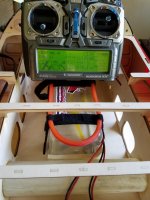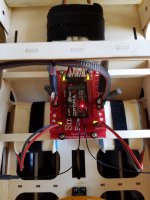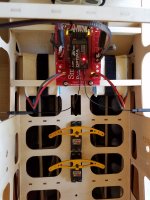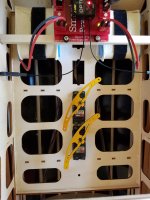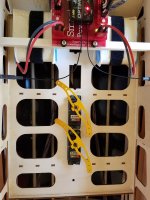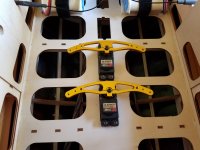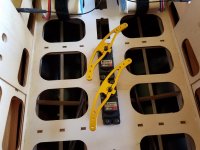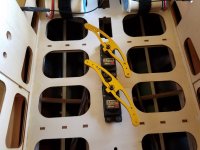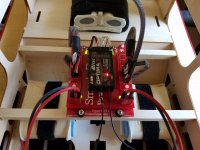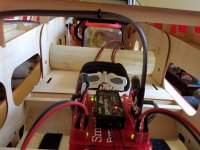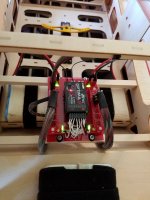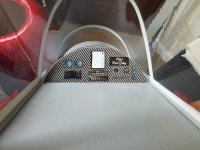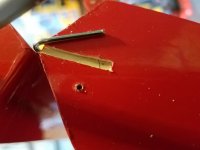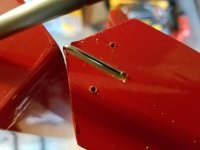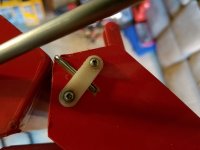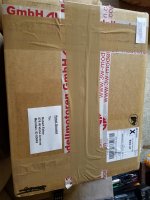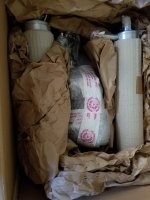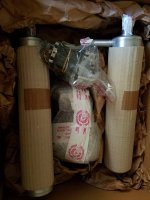Rob I hate to drag the thread for your Beautifully Bodacious Behemoth Brother of your original Breathtaking Beastie, off subject, but since the subject of the batteries your running came up, do you feel that the Li-Ion's give you enough current output for a High Voltage setup. They say the that current output is somewhat of a limiting factor of Li-Ion's compared to LiPos. The reason I ask is a buddy of mine is not a LiPo guy at all and wants to go HV on his next airplane. He runs Li-Ion's on his 40% Carf Sukhoi now, but it's through a PowerBox turned down to 6 volts for the servos he has.
For the record the 5000mah LiPo's in my new Extra were at 73% and 72% capacity after 3 flights yesterday. I didn't recharge them to see how much they used because I was too hot and tired. I just put them on a storage charge then went home.
I don't mind. This discussion is about the setup on the big Yak, so I am good with it here. I do feel that the LiIons give more than ample power for the current output on HV that my setups require. Rarely, (if ever) will we see a power requirement larger than what the circuitry can handle. And in all reality, a normal Futaba/JR servo plug end is only rated at 5 amps. Anything over that and we risk turning them into molten plastic and a disasterous outcome is inevitable. Yes I have heard of it happening. Mostly on someones setup that they "shorted" something out. Or in the event of a servo binding unexpectedly. Then of course we get a massive power drain and too many amps can be drawn through a circuit and damage is the end result. Or a completely drained and depleted battery. Which the end result is still the same. Disaster.
But if you think about it, our receivers of today as well as the power safe receivers and Power Expansion boards have busses and circuits that handle far more than we can usually throw at them. So with that being said, a 2000 mah 7.4 volt, (2s) has the same strength as a Lipo of the same size. The "C" rating is what I take to heart. If too much power exceeds that "C" rating, then certainly it does not matter if it is Lipo or LiIon for that matter. Something is going to give. And most generally at the weakest link. I think of it as this: A man can pick up a 50 pound weight...the 7.4 volts. How long he can hold it up...is the strength or the mah. So a 5200 mah LiIon is going to be just as strong as a 5200 mah Lipo. Yes, I do know the two chemistries discharge in completely different ways. If memory serves correctly, a Lipo will hold...hold....hold, then drop off suddenly. A LiIon will slowly dwindle but the drop off rate is much slower than a Lipo. So, Lets say I power up my 260 for the first flight of the day. Voltage and mah should be right near the top of the finish charge. After the second, third and etc. flights, the voltage is going to come down and equalize at the 7.4 while the mah's are going to slowly fall off. A Lipo will come right down to the cell rating of the voltage...while the mah's hold, hold, hold, fall. I think I have this right? Maybe the battery gurus can correct me and elaborate better if I am wrong. Bottom line is this, after six good hard 10 plus minute flights on the 260, the Sukhoi and even the big Yak, I noticed no difference in the speed, strength or overall performance of any of the servo's or surfaces from first to last flight. That I put back in the same equal amount of mah's after the same amounts of flights gives me a solid base line of knowing what my batteries are doing. Now if I were to notice a spike in charge mah's, that they need more to top off, then that is the time to consider replacing them. And most certainly if they get to a point where they are starting to need more to top off, then most certainly the performance of the servos are going to be affected.
Don't know if this answers your question but all in all, I do feel the LiIon has more than enough power to feed a hungry HV system. The 260, Sukhoi, Yak...even my 100cc Edges are living proof.


